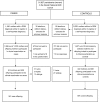Adiposity, Dysmetabolic Traits, and Earlier Onset of Female Puberty in Adolescent Offspring of Women With Gestational Diabetes Mellitus: A Clinical Study Within the Danish National Birth Cohort
- PMID: 29038315
- PMCID: PMC5711331
- DOI: 10.2337/dc17-0514
Adiposity, Dysmetabolic Traits, and Earlier Onset of Female Puberty in Adolescent Offspring of Women With Gestational Diabetes Mellitus: A Clinical Study Within the Danish National Birth Cohort
Abstract
Objective: Offspring of pregnancies affected by gestational diabetes mellitus (GDM) are at increased risk of the development of type 2 diabetes. However, the extent to which these dysmetabolic traits may be due to offspring and/or maternal adiposity is unknown. We examined body composition and associated cardiometabolic traits in 561 9- to 16-year-old offspring of mothers with GDM and 597 control offspring.
Research design and methods: We measured anthropometric characteristics; puberty status; blood pressure; and fasting glucose, insulin, C-peptide, and lipid levels; and conducted a DEXA scan in a subset of the cohort. Differences in the outcomes between offspring of mothers with GDM and control subjects were examined using linear and logistic regression models.
Results: After adjustment for age and sex, offspring of mothers with GDM displayed higher weight, BMI, waist-to-hip ratio (WHR), systolic blood pressure, and resting heart rate and lower height. Offspring of mothers with GDM had higher total and abdominal fat percentages and lower muscle mass percentages, but these differences disappeared after correction for offspring BMI. The offspring of mothers with GDM displayed higher fasting plasma glucose, insulin, C-peptide, HOMA-insulin resistance (IR), and plasma triglyceride levels, whereas fasting plasma HDL cholesterol levels were decreased. Female offspring of mothers with GDM had an earlier onset of puberty than control offspring. Offspring of mothers with GDM had significantly higher BMI, WHR, fasting glucose, and HOMA-IR levels after adjustment for maternal prepregnancy BMI, and glucose and HOMA-IR remained elevated in the offspring of mothers with GDM after correction for both maternal and offspring BMIs.
Conclusions: In summary, adolescent offspring of women with GDM show increased adiposity, an adverse cardiometabolic profile, and earlier onset of puberty among girls. Increased fasting glucose and HOMA-IR levels among the offspring of mothers with GDM may be explained by the programming effects of hyperglycemia in pregnancy.
© 2017 by the American Diabetes Association.
Figures
Similar articles
-
Maternal protein intake in pregnancy and offspring metabolic health at age 9-16 y: results from a Danish cohort of gestational diabetes mellitus pregnancies and controls.Am J Clin Nutr. 2017 Aug;106(2):623-636. doi: 10.3945/ajcn.115.128637. Epub 2017 Jul 5. Am J Clin Nutr. 2017. PMID: 28679553 Free PMC article.
-
Metabolic syndrome in childhood: association with birth weight, maternal obesity, and gestational diabetes mellitus.Pediatrics. 2005 Mar;115(3):e290-6. doi: 10.1542/peds.2004-1808. Pediatrics. 2005. PMID: 15741354
-
Fish Intake in Pregnancy and Offspring Metabolic Parameters at Age 9⁻16-Does Gestational Diabetes Modify the Risk?Nutrients. 2018 Oct 17;10(10):1534. doi: 10.3390/nu10101534. Nutrients. 2018. PMID: 30336645 Free PMC article.
-
Hyperglycemia During Pregnancy and Long-Term Offspring Outcomes.Curr Diab Rep. 2019 Nov 21;19(12):143. doi: 10.1007/s11892-019-1267-6. Curr Diab Rep. 2019. PMID: 31754898 Free PMC article. Review.
-
Offspring body size and metabolic profile - effects of lifestyle intervention in obese pregnant women.Dan Med J. 2014 Jul;61(7):B4893. Dan Med J. 2014. PMID: 25123127 Review.
Cited by
-
A Clinical Update on Gestational Diabetes Mellitus.Endocr Rev. 2022 Sep 26;43(5):763-793. doi: 10.1210/endrev/bnac003. Endocr Rev. 2022. PMID: 35041752 Free PMC article.
-
The Belgian Diabetes in Pregnancy Follow-Up Study (BEDIP-FUS): A Multi-Centric Prospective Cohort Study on the Long-Term Metabolic Risk across Different Degrees of Gestational Glucose Intolerance: Methodology and Design.J Clin Med. 2023 Jan 28;12(3):1025. doi: 10.3390/jcm12031025. J Clin Med. 2023. PMID: 36769669 Free PMC article.
-
The Impact of Maternal Gestational Diabetes Mellitus on Minipuberty in Boys.Nutrients. 2024 Nov 29;16(23):4145. doi: 10.3390/nu16234145. Nutrients. 2024. PMID: 39683537 Free PMC article.
-
Elevated Midtrimester Triglycerides as a Biomarker for Postpartum Hyperglycemia in Gestational Diabetes.J Diabetes Res. 2020 Apr 23;2020:3950652. doi: 10.1155/2020/3950652. eCollection 2020. J Diabetes Res. 2020. PMID: 32377519 Free PMC article.
-
The mechanism of maternal inheritance of glycolipid metabolism disorder in a zebrafish model of type 2 diabetes.Sci Rep. 2025 Apr 30;15(1):15198. doi: 10.1038/s41598-025-99473-z. Sci Rep. 2025. PMID: 40307382 Free PMC article.
References
-
- Egeland GM, Meltzer SJ. Following in mother’s footsteps? Mother-daughter risks for insulin resistance and cardiovascular disease 15 years after gestational diabetes. Diabet Med 2010;27:257–265 - PubMed
-
- Metzger BE. Long-term outcomes in mothers diagnosed with gestational diabetes mellitus and their offspring. Clin Obstet Gynecol 2007;50:972–979 - PubMed
-
- Donovan LE, Cundy T. Does exposure to hyperglycaemia in utero increase the risk of obesity and diabetes in the offspring? A critical reappraisal. Diabet Med 2015;32:295–304 - PubMed
Publication types
MeSH terms
Substances
Grants and funding
LinkOut - more resources
Full Text Sources
Other Literature Sources



